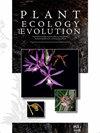贝宁热带稀树草原非洲豆属植物的空间分布格局:对管理的启示
IF 1.1
4区 生物学
Q3 PLANT SCIENCES
引用次数: 1
摘要
背景和目的-了解树种与其同种和异种邻居的空间格局和联系对其林分的可持续管理至关重要。本研究评估了贝宁热带稀树草原濒危树种非洲阿夫利亚(Afzelia africana) 6个生命阶段的种内和种间空间结构。材料和方法:沿着保护梯度(狩猎区-核心保护区)在三个地点划分了三个4公顷的地块。绘制了非洲古树(不论胸径)和异种树(胸径≥5 cm)的个体图谱。利用单变量和双变量对相关函数确定树木的空间格局和关联。进一步使用到最近邻居的距离来评估树到树的距离。主要结果-我们发现不同地点的空间模式不同。在野生动物密度高的核心区,大部分生命阶段呈随机分布。而在野生动物密度较低的狩猎区,物种空间分布由早期以聚集为主转变为超大型成虫的非聚集或随机空间格局。除了体型小的和体型大的成年个体在两个位点上存在正相关外,大多数成对的生命阶段表现为中性关联。我们还发现非洲古树的空间分布与异种树无关。结论:我们认为森林火灾、种子传播、捕食和当地环境可能对观察到的模式有贡献。本文章由计算机程序翻译,如有差异,请以英文原文为准。
Spatial distribution patterns of Afzelia africana (Fabaceae – Detarioideae) in a tropical savanna of Benin: implications for management
Background and aims – Understanding the spatial patterns and associations of tree species with their conspecific and heterospecific neighbours is critical for sustainable management of their stands. This study assessed the intra- and interspecific spatial structure of six life stages in Afzelia africana, a keystone multipurpose and endangered tree species in a tropical savanna of Benin.Material and methods – Three plots of 4 ha each were demarcated on three sites along a conservation gradient (hunting zone – core conservation zone). Individuals of A. africana (irrespective of their diameter at breast height) and heterospecific trees (dbh ≥ 5 cm) were mapped. Tree spatial patterns and associations were determined using univariate and bivariate pair correlation functions. The distance to the nearest neighbour was further used to assess tree-to-tree distance.Key results – We found variable spatial patterns across sites. In the core zone where wildlife density is high, most life stages had a random distribution. In contrast, in the hunting zone where wildlife density is low, the species spatial distribution changed from a predominantly aggregative pattern during early stages to a less aggregative or random spatial pattern for very large adults. Most pairs of life stages showed neutral associations, except for small and large adults, which had positive association between themselves on two sites. We also found that A. africana tree spatial distribution was unrelated to heterospecific trees.Conclusion – We suggest that bush fire, seed dispersion, predation, and local environment would have contributed to the observed patterns.
求助全文
通过发布文献求助,成功后即可免费获取论文全文。
去求助
来源期刊

Plant Ecology and Evolution
PLANT SCIENCES-
CiteScore
2.20
自引率
9.10%
发文量
27
审稿时长
>12 weeks
期刊介绍:
Plant Ecology and Evolution is an international peer-reviewed journal devoted to ecology, phylogenetics and systematics of all ‘plant’ groups in the traditional sense (including algae, cyanobacteria, fungi, myxomycetes), also covering related fields.
The journal is published by Meise Botanic Garden and the Royal Botanical Society of Belgium.
 求助内容:
求助内容: 应助结果提醒方式:
应助结果提醒方式:


